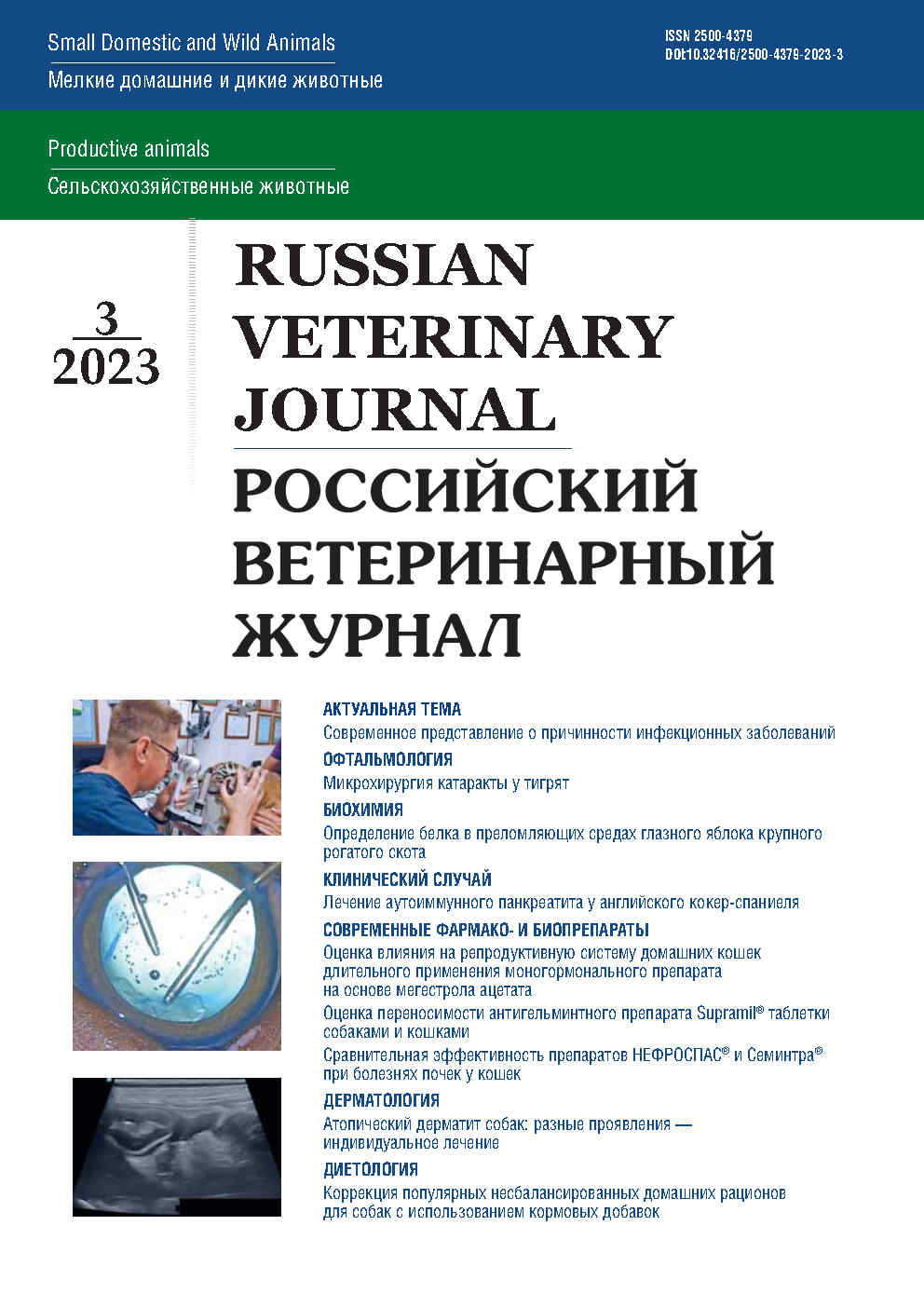Russian Federation
CSCSTI 68.41
Cataracts are common in young tiger cubs who grew up in captivity due to the lack of mother 's milk and eating of artificial food additives with cataractogenic effects. The onset of maturation of cataracts and decreased vision is noted in 2…3 months. The development of lens opacity in tiger cubs occurs quickly, literally in a few weeks. Mature cataract first leads to complete blindness of the animal, and then the possible death of the eye due to swelling of the lens with the development of terminal phacogenic glaucoma or autoimmune panophthalmitis. Microsurgical removal of cataracts is the only effective way to restore visual functions in young tigers with cataracts. This article describes our comparative experience microsurgery of cataracts of 8 tiger cubs aged 2.5 to 5 months by ultrasound phacoemulsification and soft lens aspiration surgery. The surgeries were carried out without complications. The animals had a significant improvement in visual functions 2…3 days after surgery. They started freely navigate in space, play with toys. Their behavior has changed significantly: inhibition and timidity have completely disappeared.
alimentary cataract, blindness, tiger cub, phacoemulsification, aspiration-irrigation of the soft lens
1. Ioshin I.E., Fakoe`mul`sifikaciya [Phacoemulsification], Moscow, 2012, pp. 26-27 (In russ.).
2. Malyugin B.E., Xirurgiya katarakty` i intraokulyarnaya korrekciya: itogi i perspektiva [Cataract surgery and intraocular correction: results and prospects]. Abstracts of reports of IX Congress of ophthalmologists of Russia, Moscow, 2010, pp. 192-195. (Un russ.)
3. Trubilin V.N., Sinyagovskaya V.V., Metod sochetannoj koaksial`no-bimanual`noj irrigacii-aspiracii pri udalenii xrustalikovy`x mass v xode fakoe`mul`sifikacii katarakty` [Method of combined coaxial-bimanual irrigation-aspiration during removal of lens masses during cataract phacoemulsification], Abstracts of reports scientific and practical conference of ophthalmologists of the Southern Federal District «Innovative technologies in ophthalmological practice of the regions», 28-29 Sep 2012, Astrakhan, 2012, pp. 195-196 (In russ.)
4. Shilkin A.G., Rotanov D.A., Pavlova T.N., Artiushina J.J., Novikova K.A., Vy`sokochastotny`j zadnij kapsulorekis pri ul`trazvukovoj mikroxirurgii vrozhdenny`x katarakt u zhivotny`x [High Frequency Posterior Capsulorhexis for Ultrasonic Microsurgery in Dogs and Cats with Congenital Cataracts], Rossijskij veterinarnyj zhurnal (Russian veterinary journal), 2016, No 1, pp. 6-9. (In russ.)
5. Shilkin A.G., Artiushina J.Yu., Rotanov D.A., Pavlova T.N., Voitekha M.A., Zubkova E.V., Mikroxirurgiya dislocirovanny`x xrustalikov u koshek i sobak posredstvom operacii «otkry`toe nebo» Microsurgery of lens dislocation in cats and dogs by «open sky» operation, Rossijskij veterinarnyj zhurnal (Russian veterinary journal), 2019, No. 5, pp. 5-11. (In russ.)
6. Adkins E.A., Hendrix D.V., Outcomes of dogs presented for cataract evaluation: a retrospective study, J Am Anim Hosp Assoc, 2005 Jul-Aug, No. 41(4), pp. 235-240.
7. Appel S.L., Maggs D.J., Hollingsworth S.R., Kass P.H., Evaluation of client perceptions concerning outcome of cataract surgery in dogs, J Am Vet Med Assoc, 2006 Mar 15, No. 228(6), pp. 870-875.
8. Cooley P.L., Phacoemulsification in a clouded leopard (Neofelis nebulosa), Vet Ophthalmol, 2001, No. 4(2), pp. 113-117.
9. Gelatt K.N., Mackay E.O., Prevalence of primary breed-related cataracts in the dog in North America, Vet Ophthalmol, 2005 Mar-Apr, No. 8(2), pp. 101-111.
10. Chandrasekara-Iyer R., Kalaka R., Lakshmanan N., Kumar A., William J., Thirumurugan R., Cataract Extraction by Phacoemulsification Procedure in a Hybrid Lion (Panthera leo persica), Iran J Vet Surg, 2022, No. 17(2), Serial No: 37, pp. 169-173.
11. Lange R.R., Lima L., Frühvald E., Cataracts and strabismus associated with hand rearing using artificial milk formulas in Bengal tiger (Panthera tigris spp tigris) cubs, Open Veterinary Journal, 2017, Vol. 7(1), pp. 23-31.
12. Rubin L.F., Hereditary cataract in Himalayan cats, Feline Pract, 1986, No. 16(1), pp. 14-15.
13. Sigle K.J., Nasisse M.P., Long-term complications after phacoemulsification for cataract removal in dogs: 172 cases (1995-2002), J Am Vet Med Assoc, 2006 Feb 15, No. 228(4), pp. 552.
14. Slatter D., Fundamentals of veterinary ophthalmology, 2nd edn. Philadelphia, Saunders, 1990, pp 365-393.
15. Seitz R., Weisse I., Operation on a congenital cataract in a Siberian Tiger, Ophthalmologica, 1979, No. 178(1-2), pp. 56-65.
16. Olivero D.K., Riis R.C., Dutton A.G., Murphy C.G., Nasisse M.P., Davidson M.G., Feline lens displacement. A retrospective analysis of 345 cases, Progr Vet Comp Ophthalmol, 1991, No. 1(4), pp. 2.
17. Wallace M.R., MacKay E.O., Gelatt K.N., Andrew S.E., Inheritance of cataract in the Bichon Frise, Vet Ophthalmol, 2005 May-Jun, No. 8(3), pp. 203-205.








